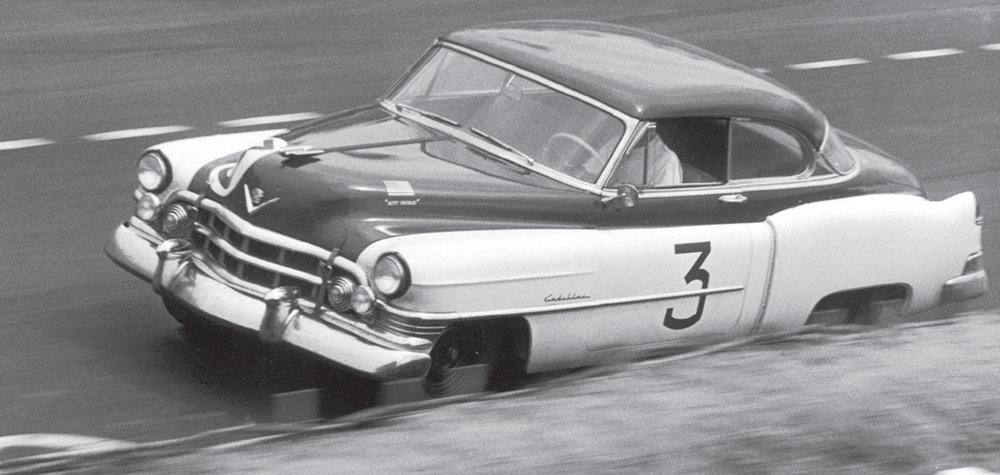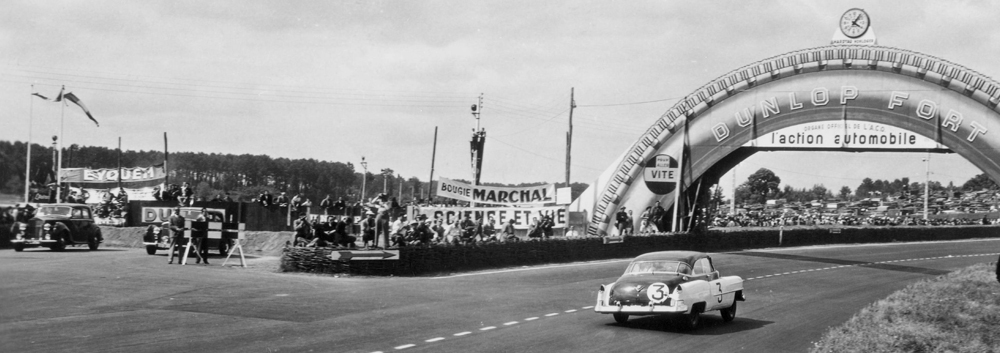
Cadillac – More Than a Century of Automotive Innovation and Racing
Cadillac has set the standards in bold design and ingenious technology. Features that are now taken for granted were hailed as technological breakthroughs when Cadillac introduced them on production vehicles. The list of Cadillac innovations includes the first self-starter, the first independent front suspension and the first synchronized transmission. Cadillac raised the bar in powertrains with elegant V-8, V-12 and V-16 engines. Cadillac also introduced America’s first transverse-V-8/front-wheel-drive automobile.
Cadillac’s reputation for innovation reaches back to the first Cadillac automobile completed by company founder Henry M. Leland on Oct. 17, 1902. With a background in manufacturing firearms and fine tools, Leland brought a passion for precision to the fledgling automotive industry. His first single-cylinder Cadillac engine produced a then-astounding 10 horsepower, easily surpassing the output of his rivals’ powerplants. With variable intake valves and rack-and-pinion steering, Leland’s Cadillac Model A was a technological tour de force. The public responded to this advanced design; in spite of the Model A’s princely $750 price tag, the first production run sold out at the 1903 New York Automobile Show.
Leland imported precision gauges from Sweden that allowed Cadillac craftsmen to manufacture components with standardized dimensions. In 1908, Cadillac became the first American automaker to win the Royal Automobile Club of Great Britain’s prestigious Dewar Trophy for significant automotive advancements. Three randomly selected Cadillacs were disassembled, their parts scrambled, and the three vehicles reassembled using only hand tools. A 500-mile road test proved the interchangeability of each car’s 721 components. With this impressive demonstration, Cadillac became the benchmark in automotive technology.
The pace of progress accelerated rapidly for Cadillac and the automobile industry. In 1910, Cadillac introduced closed bodywork as standard equipment and offered Delco’s new coil and point ignition system, a major improvement over unreliable magneto ignitions.
Two years later, Cadillac became the first automaker to use a sophisticated Delco electrical system that combined self-starting, ignition and lighting functions. The Royal Automobile Club awarded Cadillac the Dewar Trophy for the second time, making it the first car company to win the award twice, and honored Cadillac as “the standard of the world.”
Cadillac’s tradition of great powertrains began in 1915 with the introduction of the first mass-produced V-8 engine. This powerplant used a thermostat to control the flow of coolant, an innovation that was universally adopted by other manufacturers. The engine, clutch and gearbox were bolted together to form a single assembly.
Ten years later, Cadillac made another breakthrough in engine technology with a dual-plane V-8 crankshaft. By arranging the connecting rod journals at 90-degree intervals and adding counterweights to the crankshaft, Cadillac engineers produced a perfectly balanced V-8 engine with exceptional smoothness.
The redesigned Cadillac V-8 signaled the beginning of an era of impressive multi-cylinder engines. In 1930, Cadillac introduced the world’s first V-16 engine for passenger car use. With overhead valves, hydraulic lash adjusters, twin carburetors, dual exhaust and an elegant exterior design, the V-16 made an unmistakable statement about Cadillac’s standing among the world’s finest automobiles. The 452-cubic-inch V-16 delivered 160 horsepower, while a V-12 version introduced in the same model year produced 135 horsepower from 368 cubic inches.
The Cadillac multi-cylinder motors were more than engines; they were automotive art. Cadillac advertisements heralded them as “Works of the Modern Masters” and described the V-16 as “the very finest of its kind.” That was no hollow boast. The motoring press hailed the V-16 as “the last word in automotive design in America.” The public agreed, but as the Great Depression descended, few could afford luxury motor cars.
Cadillac’s exquisite engines were coupled with a fully synchronized transmission design that debuted in 1929. The Cadillac “Synchro-Mesh Silent-Shift” transmission employed bronze cones to match the gear speeds while shifting. The days of double clutching and noisy gear changes were over for Cadillac drivers, and the standard of the world was raised another notch.
Manual gear changes could be eliminated altogether with the introduction of Cadillac’s optional fully automatic transmission in 1941. Pioneered in 1940 by Oldsmobile, Cadillac’s General Motors sister division, the Hydra-Matic four-speed automatic employed a fluid coupling and a hydraulic “brain” that controlled gear changes.
Research on high-performance aircraft engines during World War II paid a peace dividend when high-octane gasoline became available. Cadillac engineers designed a new high-compression engine that took advantage of the power-enhancing properties of this new fuel. In 1949, Cadillac introduced the first modern mass-produced overhead-valve V-8. Rated at an astounding 160 horsepower, the 331-cubic-inch Cadillac V-8 featured a short stroke and lightweight construction. It weighed 200 pounds less than the flathead V-8 it replaced.
Racers quickly recognized the advantages of the new Cadillac powerplant. Famed Indy driver Paul Russo won the 1949 Milwaukee 100 stock car race in a Cadillac, and Red Byron finished third in the 1950 NASCAR Southern 500 in Darlington, S.C., Gober Sosebee took the pole position and finished second in a 100-mile NASCAR Grand National race on a half-mile dirt track in Columbus, Ga., in June 1951.
In 1952, Buck Baker won a 250-mile race in NASCAR’s Speedway division in a Cadillac-powered Indy-style car, and Tom Deal’s Cadillac finished second in the La Carrera Panamericana road race in Mexico. Cadillac engines powered Briggs Cunningham’s limited-production sports cars and made the English-built Allard J-2 the car to beat on road courses from Watkins Glen, N.Y., to Pebble Beach, Calif.

Cadillac even traveled the long and winding road to Le Mans, France, the home of the 24 Hours of Le Mans endurance race. Briggs Cunningham, a well-heeled sportsman and racing enthusiast, led the way. His American-based team brashly entered a pair of Cadillacs in the 1950 edition of Europe’s classic road race. The first was a stock-bodied 61 Series coupe and the second a stunning rebodied chassis that was affectionately named “Le Monstre” by the astonished French fans. Cunningham’s fresh-from-the-showroom Cadillac finished 10th; his aero-bodied creation posted a respectable 11th-place finish in spite of an excursion into a gravel trap. A Cadillac-Allard J2 entry, driven by Tom Cole and Sydney H. Allard, finished third overall and first in the over-8000cc class.
In addition to engineering excellence, expressive styling was a lynchpin of Cadillac’s image. The custom-built coachwork of the classic era gave way to extravagantly sculptured sheet metal. GM introduced the industry’s first curved windshields in 1948, and the first tail fin made its modest debut on a Cadillac. Inspired by the twin rudders on Lockheed P38 aircraft, the tail fin would become a defining characteristic of Cadillac automobiles for decades.
The exuberance of the ’50s found expression in Cadillac’s ultra-luxurious 1957 Eldorado Brougham, a memorable automobile that introduced the quad headlamp system, a brushed stainless steel roof panel, a power seat with memory, automatic door locks, low-profile tires, forged aluminum wheels and air suspension. Like other Cadillac models, the Brougham featured a foot-operated parking brake that automatically released when the transmission was shifted into gear. The tail fin reached its apogee on 1959 models, which sported the tallest fins in Cadillac history.
Cadillac continued to refine the driving experience in the ’60s by making comfort and convenience top priorities. Self-adjusting brakes were adopted in 1960, and Cadillac introduced Climate Control in 1964, the industry’s first thermostatically regulated heating, ventilating and air conditioning system. Cadillac’s new Twilight Sentinel automatically turned on the headlamps at dusk, and an adjustable steering wheel that tilted and telescoped appeared on Cadillac models in 1965.
Cadillac also made strides in safety over the decades. In 1954, Cadillac’s innovative padded dashboard was seen as a state-of-the-art safety device. Ten years later, front seat belts became standard Cadillac equipment. Computerized anti-lock rear brakes were introduced as optional equipment in 1971, and in 1974, Cadillac pioneered the use of an air cushion restraint (air bag) system to help protect the driver in a frontal collision.
With the development of microprocessors, electronically controlled systems opened new avenues for Cadillac engineers. In 1975, Cadillac became the first U.S. manufacturer to use electronic fuel injection. The 1978 Seville was equipped with a trip computer, and two years later integrated circuits took charge of fuel injection, ignition and vehicle diagnostics. Cadillac introduced the first front-wheel-drive vehicle with electronic traction control in 1990. Other advances in digital technology were quickly adapted to Cadillac vehicles, with a computer-controlled suspension system and speed-sensitive steering introduced in 1993.
The sophisticated OnStar communication service debuted on three Cadillac models in 1997, combining Global Positioning System (GPS) technology, cellular telephone communications and 24-hour customer assistance. Night Vision, the first automotive application of infrared technology, bowed on the 2000 DeVille. This system uses infrared imaging to allow the driver to “see” the heat emitted by humans, animals and moving vehicles even in darkness.
Powertrain technology has also changed since the days of the V-16 engines. The carburetors and overhead valves that were cutting-edge technology have been supplanted by electronic fuel injection, multi-valve cylinder heads and double overhead camshafts. In 1992, Cadillac unveiled the 4.6-liter Northstar V-8, the first member of a new family of GM Premium V engines. GM Racing, the technical arm of GM’s motorsports program, developed several competition versions of the Premium V engine, including a twin-turbocharged Northstar V-8 that powered the Cadillac Northstar Le Mans Prototype in the American Le Mans Series. The small-block V-8s that power the production CTS-V and the CTS-V race car are among the most powerful small-block engines ever produced. The transmissions in the CTS-V race cars use a synchronizer design developed by Cadillac years ago as “Silent Shift,” although the original bronze synchronizer pads are replaced with carbon composite material in the modern version.


You must be logged in to post a comment.